Paper Mario (series): Difference between revisions
(→Characters: Fillec out the table with all of the partners from Paper Mario) Tag: Mobile edit |
(→Major Protagonists: Filled about half of the partners in The Thousand-Year Door) Tag: Mobile edit |
||
| Line 126: | Line 126: | ||
|- | |- | ||
|align="center"|[[File:Paper Luigi Jump.png|100px]] | |align="center"|[[File:Paper Luigi Jump.png|100px]] | ||
|Luigi often acts as an NPC, who in ''Paper Mario'' stays at the [[Mario Bros.' House]] and in ''Paper Mario: The Thousand Year Door'' goes on his own adventure which Mario can hear about if he talks to him. Luigi took on a more major role in ''Super Paper Mario'', where for most of the game he is brainwashed and turned into [[Mr. L]] who works for [[Count Bleck]], but after Chapter 6 he is turned back to normal and becomes a playable character. While playing as Luigi, as usual he has a higher jump height and lower ground traction, and he can also do a [[Super jump (Super Paper Mario)|Super Jump]], which can be used to jump super high or deal double-damage to enemies directly above him. In ''Paper Mario: Sticker Star'' and ''Paper Mario: Color Splash'', Luigi hides in certain spots in some levels and can be pulled out by using [[Paperize]] and [[Cutout]] respectively. In the latter, Luigi also helps Mario reach [[Black Bowser's Castle]]. | |Luigi often acts as an NPC, who in ''Paper Mario'' stays at the [[Mario Bros.' House]] and in ''Paper Mario: The Thousand-Year Door'' goes on his own adventure which Mario can hear about if he talks to him. Luigi took on a more major role in ''Super Paper Mario'', where for most of the game he is brainwashed and turned into [[Mr. L]] who works for [[Count Bleck]], but after Chapter 6 he is turned back to normal and becomes a playable character. While playing as Luigi, as usual he has a higher jump height and lower ground traction, and he can also do a [[Super jump (Super Paper Mario)|Super Jump]], which can be used to jump super high or deal double-damage to enemies directly above him. In ''Paper Mario: Sticker Star'' and ''Paper Mario: Color Splash'', Luigi hides in certain spots in some levels and can be pulled out by using [[Paperize]] and [[Cutout]] respectively. In the latter, Luigi also helps Mario reach [[Black Bowser's Castle]]. | ||
|<center>''[[Paper Mario]]''</center> | |<center>''[[Paper Mario]]''</center> | ||
|- | |- | ||
| Line 150: | Line 150: | ||
|- | |- | ||
|align="center"|[[File:PM Bombette.png|100px]] | |align="center"|[[File:PM Bombette.png|100px]] | ||
|Bombette is Mario's third partner in ''Paper Mario''. She was initially one of many Bob-ombs working at [[Koopa Bros. Fortress]] until the [[Koopa Bros.]] imprisoned her and most of the other Bob-ombs. She joins Mario after he helps her escape her jail cell. In the field, she can blow up cracks in walls or deal a [[First Strike]] to an enemy. In battle, she can [[Body Slam]] into the enemy at the front or [[Bomb]] it. When Super-Ranked, she can use [[Power Bomb]] to damage all enemies on the ground. When Ultra-Ranked, she can use [[Mega Bomb]] to damage all enemies. | |Bombette is Mario's third partner in ''Paper Mario''. She was initially one of many Bob-ombs working at [[Koopa Bros. Fortress]] until the [[Koopa Bros.]] imprisoned her and most of the other Bob-ombs. She joins Mario after he helps her escape her jail cell. In the field, she can blow up cracks in walls or deal a [[First Strike]] to an enemy. In battle, she can [[Body Slam (Paper Mario)|Body Slam]] into the enemy at the front or [[Bomb]] it. When Super-Ranked, she can use [[Power Bomb]] to damage all enemies on the ground. When Ultra-Ranked, she can use [[Mega Bomb]] to damage all enemies. | ||
|<center>''[[Paper Mario]]''</center> | |<center>''[[Paper Mario]]''</center> | ||
|- | |- | ||
| Line 156: | Line 156: | ||
|- | |- | ||
|align="center"|[[File:Mario and Parakarry Artwork - Paper Mario.png|100px]] | |align="center"|[[File:Mario and Parakarry Artwork - Paper Mario.png|100px]] | ||
|Parakarry is Mario's fourth partner in ''Paper Mario''. In this game and in ''Paper Mario: The Thousand Year Door'', he delivers a letter to Mario which starts off the adventure. He lost a lot of [[List of letters in Paper Mario|letters]] throughout the Mushroom Kingdom, and joins Mario after finding his lost letters on [[Mt. Rugged]]. In the field, Parakarry can deliver letters to recipients if Mario talks to them while he is active, and he can carry Mario over large gaps. In battle, he can use [[Sky Dive]] or [[Shell Shot]] to damage one enemy. When Super-Ranked, he can use [[Air Lift]] to carry an enemy out of the battle. When Ultra-Ranked, he can use [[Air Raid]] to damage all enemies. | |Parakarry is Mario's fourth partner in ''Paper Mario''. In this game and in ''Paper Mario: The Thousand-Year Door'', he delivers a letter to Mario which starts off the adventure. He lost a lot of [[List of letters in Paper Mario|letters]] throughout the Mushroom Kingdom, and joins Mario after finding his lost letters on [[Mt. Rugged]]. In the field, Parakarry can deliver letters to recipients if Mario talks to them while he is active, and he can carry Mario over large gaps. In battle, he can use [[Sky Dive]] or [[Shell Shot]] to damage one enemy. When Super-Ranked, he can use [[Air Lift]] to carry an enemy out of the battle. When Ultra-Ranked, he can use [[Air Raid]] to damage all enemies. | ||
|<center>''[[Paper Mario]]''</center> | |<center>''[[Paper Mario]]''</center> | ||
|- | |- | ||
| Line 162: | Line 162: | ||
|- | |- | ||
|align="center"|[[File:Bow.png|100px]] | |align="center"|[[File:Bow.png|100px]] | ||
|Lady Bow is Mario's fifth | |Lady Bow is Mario's fifth partner in ''Paper Mario''. She is the master of [[Boo's Mansion]], and after [[Tubba Blubba]] began eating Boos, [[Bootler]] brought Mario to her where she offers to set free the [[Star Spirit]] [[Skolar]] (who escaped from [[Tubba Blubba's Castle]]) in exchange of defeating Tubba Blubba. She joins Mario to help him do this, then decides to stick with him for the rest of the adventure. In the field, she can make Mario transparent to avoid detection from enemies or pass through obstacles while on a moving surface (e.g a Lava waterfall in Bowser's Castle). In battle, she can [[Smack]] one enemy or use [[Outta Sight]] to make herself and Mario immune to the next enemy turn, although this will also skip Bow's next turn. When Super-Ranked, she can use [[Spook (move)|Spook]] to scare enemies away. When Ultra-Ranked, she can [[Fan Smack]] an enemy. | ||
|<center>''[[Paper Mario]]''</center> | |<center>''[[Paper Mario]]''</center> | ||
|- | |- | ||
| Line 168: | Line 168: | ||
|- | |- | ||
|align="center"|[[File:Watt Artwork - Paper Mario.png|100px]] | |align="center"|[[File:Watt Artwork - Paper Mario.png|100px]] | ||
|Watt is Mario's sixth | |Watt is Mario's sixth partner in ''Paper Mario''. She was trapped in a lantern held by a [[Big Lantern Ghost]] in [[Shy Guy's Toy Box]], and joins Mario after he rescues her. In the field, she can light up dark areas and reveal [[List of hidden blocks in Paper Mario|hidden blocks]]. In battle, she can use [[Electro Dash]] to attack one enemy and pierces its defense, or use [[Power Shock]] to paralyze one enemy. When Super-Ranked, she can use [[Turbo Charge]] to boost Mario's attack power. When Ultra-Ranked, she can use [[Mega Shock]] to paralyze all enemies. | ||
|<center>''[[Paper Mario]]''</center> | |<center>''[[Paper Mario]]''</center> | ||
|- | |- | ||
| Line 180: | Line 180: | ||
|- | |- | ||
|align="center"|[[File:Lakilester Artwork - Paper Mario.png|100px]] | |align="center"|[[File:Lakilester Artwork - Paper Mario.png|100px]] | ||
|Lakilester is Mario's eighth and final | |Lakilester is Mario's eighth and final partner in ''Paper Mario''. He was a minion of [[Huff N. Puff]] and picks a fight with Mario under orders from him. After losing the fight, Lakilester decides to betray Huff N. Puff and joins Mario's side. In the field, Mario can ride on Lakilester's cloud to move at a faster speed than normal, and can hover acrosd spikes and lava. In battle, he can use [[Spiny Flip]] to throw a Spiny Egg at an enemy, or use [[Spiny Surge]] to throw a bunch of Spiny Eggs at all enemies. When Super-Ranked, he can use [[Cloud Nine]] to make enemy attacks sometimes miss Mario. When Ultra-Ranked, he can use [[Hurricane (move)|Hurricane]] to blow all enemies away. | ||
|<center>''[[Paper Mario]]''</center> | |<center>''[[Paper Mario]]''</center> | ||
|- | |||
!colspan="3" style="font-size:125%;text-align:left"|[[Goombella]] | |||
|- | |||
|align="center"|[[File:Goombella2.jpg|100px]] | |||
|Goombella is Mario's first partner in ''Paper Mario: The Thousand-Year Door''. She went to [[Rogueport]] to learn about the Legendary Treasure under the city, and joins Mario after he rescues her from [[Lord Crump]] and some [[X-Naut]]s. She behaves exactly like Goombario in the field and in battle, except she learns [[Multibonk]] when Super-Ranked, and when Ultra-Ranked, she can use [[Rally Wink]] which lets Mario use another action. | |||
|<center>''[[Paper Mario: The Thousand-Year Door]]''</center> | |||
|- | |||
!colspan="3" style="font-size:125%;text-align:left"|[[Koops]] | |||
|- | |||
|align="center"|[[File:Koops - PMTTYD.png|100px]] | |||
|Koops is Mario's second partner in ''Paper Mario: The Thousand-Year Door''. Ten years before the events of the game, [[Koopley|his father]] went to fight [[Hooktail]] but was believed to have died. Wanting to avenge his father, Koops went with Mario to [[Hooktail Castle]]. After defeating Hooktail and realizing his father was alive, Koops decided to continue travelling with Mario. He behaves exactly like Kooper in the field and in battle, except his shell toss in the field can be held down while Mario can move around. When Super-Ranked, he can protect Mario in a [[Shell Shield]]. When Ultra-Ranked, he can use [[Shell Slam]] to attack all enemies on the ground and pierce their defence. | |||
|<center>''[[Paper Mario: The Thousand-Year Door]]''</center> | |||
|- | |||
!colspan="3" style="font-size:125%;text-align:left"|[[Flurrie]] | |||
|- | |||
|align="center"|[[File:Flurrie (alt) - Paper Mario The Thousand-Year Door.png|100px]] | |||
|Flurrie is Mario's third partner in ''Paper Mario: The Thousand-Year Door''. She was a retired actress who lives in [[Boggly Woods]] and was planning a stage comeback. She joins Mario after he finds her Necklace for her. In the field, she can exhale to reveal hidden things and stop enemies in their tracks. In battle, she can [[Body Slam (Paper Mario: The Thousand-Year Door)|Body Slam]] an enemy from above or use [[Gale Force]] to blow all enemies away. When Super-Ranked, she can use [[Lip Lock]] to damage an enemy and heal her own HP. When Ultra-Ranked, she can use [[Dodgy Fog]] to make enemie attacks sometimes miss Mario. | |||
|<center>''[[Paper Mario: The Thousand-Year Door]]''</center> | |||
|- | |||
!colspan="3" style="font-size:125%;text-align:left"|[[Mini-Yoshi]] | |||
|- | |||
|align="center"|[[File:Yoshikid.jpg|100px]] | |||
|Mini-Yoshi is Mario's fourth partner in ''Paper Mario: The Thousand-Year Door''. He hatched from his egg in [[Glitzville]] while Mario was fighting in the [[Glitz Pit]], and joined Mario not long afterwards. The player gives him a name beforehand. In the field, Mario can ride him to move at a faster pace and hover over large gaps. In battle, he can [[Ground Pound]] an enemy or can [[Gulp]] the enemy at the front and spit it at the enemy behind it damaging them both (this is the only way to defeat the [[Armored Harriers]]). When Super-Ranked, he can throw [[Mini-Egg]]s at enemies to shrink them. When Ultra-Ranked, he can summon a [[Stampede (Paper Mario: The Thousand-Year Door)|Stampede]] of Yoshis to attack all enemies. | |||
|<center>''[[Paper Mario: The Thousand-Year Door]]''</center> | |||
|} | |} | ||
Revision as of 14:58, March 17, 2019
Template:Series-infobox Paper Mario is a role-playing game spin-off series of the Mario franchise, developed for Nintendo by affiliate company Intelligent Systems. The series is renowned for its distinctive visual style, which consists of 2D paper cutout characters moving about in 3D papercraft worlds. It is considered a thematic and spiritual sequel to Super Mario RPG: Legend of the Seven Stars, the first game to introduce RPG elements into the Mario franchise, and follows many conventions established in that game. The first installment in the Paper Mario series was launched on Nintendo 64 in 2000/2001, and four sequels have since followed: three for home consoles, and one handheld entry.
Gameplay and premise
Paper Mario combines traditional role-playing gameplay elements with concepts and features from the Mario franchise. The main protagonist, Mario, overcomes obstacles placed in the game's overworld by jumping and using his hammer. The graphics consist of a mixture of 3D environments and 2D characters who look as if they are made of paper. Battles in the Paper Mario games borrow elements from Super Mario RPG and traditional role-playing titles; and feature a turn-based system, in which players select an attack, defense, or item from a menu; and an "action commands" mechanic where the player can receive substantial attack or defense bonuses when they perform a timed button press correctly or follow some other instruction. Mario's health is measured in Heart Points (HP), of which one or more are consumed by attacks from the enemies he combats in battle; once his HP is reduced to zero, the game will end and the player will have to reload from the last save point reached.
Original format
The first three Paper Mario games present their stories in the context of a novel, divided into eight chapters (nine counting the prologue).
In the first three games, Mario gathers around him partners with specialized skills required to advance progression in the game, and must often face puzzles and boundaries based around said partners' abilities. The partners are accumulated as the player advances into different locations; only one may accompany Mario in the overworld, although the player can interchange them at any time. Partner characters can also assist Mario in battle. In the first Paper Mario, damage inflicted against them results in temporary paralysis. By Paper Mario: The Thousand-Year Door, partners were given their own HP meters and were able to receive the same kinds of damage inflicted upon Mario; when their HP is reduced to zero, the partner becomes inactive for the rest of that battle and later battles until recovery.
The early Paper Mario games also feature special moves which Mario and his partners can perform with a finite capacity; each move consumes a particular number of Flower Points (FP) when performed, and as with HP, these statistics were originally only assigned to Mario, but were shared among him and his party members by The Thousand-Year Door. Both HP and FP can be increased upon a "level up," which occurs every time the player reaches or exceeds 100 experience points, called "Star Points" in-game; these are earned in various numbers once Mario has finished a battle. The first two Paper Mario games also feature an on-screen gauge to display "Star Power," which is required to perform moves of another type that accumulate in number as the player progresses through the game. The first two Paper Mario games' battles take place on a stage. The Thousand-Year Door also has Mario battle in front of an audience, who can assist him by replenishing Star Power, throwing helpful items at him, or inflicting damage on the opponent if he performs well in combat; for every 10 levels, the stage will increase by fifty audience members for a total of 200 after level 30.
The original Paper Mario games allow the player to locate hidden battle upgrades in the game's overworld, promoting one partner character to a new rank at a time. In The Thousand-Year Door, Mario is "cursed" at different points in-game with abilities that enable special moves in the overworld, all based around the paper theme: Mario can fold into a boat or paper airplane by standing on a special activation panel, roll up into a scroll of paper, or become paper-thin. This game's environments also follow the paper theme; for example, illusory objects that conceal secret items or switches can be blown away by a gust of wind due to the environment's paper-like qualities.
Progression through the Paper Mario games depends upon interaction with the non-player characters (NPCs), who will often offer clues or detail the next event in the storyline. As in other RPGs, the player can find or purchase stat-boosting items from NPCs to help in and outside of combat. The effects of items range from healing Mario to damaging the opponent. Badges can also be obtained that yield bonuses during combat, like added moves and gradual health restoration; each consumes a set number of Badge Points (BP), meaning Mario can only equip a limited number of badges at a time. Badges, like items, can be purchased from NPCs in shops or obtained from defeated enemies. When equipped, badges can permanently enhance a particular skill or aspect; some badges, such as Power Jump or Quake Hammer, can even give Mario new moves.
The first two entries in the series feature special sidequests, which recur upon the completion of most game chapters, where Princess Peach is playable; these transitions feature varying objectives and actions, mostly stealth-based. In The Thousand-Year Door, Bowser got his own sidequests where he traverses through multiple side-scrolling levels based on the original Super Mario Bros.
Super Paper Mario
Super Paper Mario changed the series' format to blend RPG gameplay with platforming gameplay. The majority of the gameplay is in 2D, but Mario is also given the ability to "flip" into 3D. By doing so, the perspective shifts and the 2D level rotates to reveal a hidden z-axis, placing Mario in a 3D environment. Mario can thereby maneuver around obstacles impassable in the 2D perspective, or find items, enemies or varying landscapes only visible along the z-axis. There is a drawback to this, however; if the player stays in the 3D perspective too long, the HP meter is depleted, one point at a time.
The game uses a scoring system where points are accumulated through defeating enemies and using items. Like the pre-existing Star Point system, this system allows players to level up and gain stronger attacks and higher resistance to damage from enemies or hazards. Peach, Bowser, and Luigi become secondary player characters over whom the player gains control as the game progresses, with each having their own sets of abilities independent of Mario's: Peach can float over long distances and block attacks with her parasol, Bowser can use his fire breath, and Luigi can perform a special jump where he folds and then launches into the air. The Super Paper Mario format also does not make use of the standard turn-based format; instead, enemies are fought directly upon encounter.
Partners appear in the form of "Pixls," digital fairy-like characters who grant the player abilities such as throwing or destroying obstacles, becoming tiny, or defending against enemies. One of these, Tippi, can also allow the Wii Remote pointer to be used like a spotlight in highlighting and reading the descriptions of items and enemies, or in spotting hidden objects.
Post-2012 format
In Paper Mario: Sticker Star, the gameplay was overhauled again, with this formula differing drastically from those of previous games in the series. Various critical elements of the original gameplay are absent, namely special moves points, badges, the experience point system, and the use of partners. As such, Sticker Star and its follow-up game Paper Mario: Color Splash are not classified as RPGs per se, but are instead action-platformers designed in an RPG style. Both games also mostly excluded new characters unique to the series and a similar setting with previous games, the reason being that Shigeru Miyamoto felt a more complex plot was unnecessary in a Mario game.[1]
Instead of partners as employed in the first Paper Mario and The Thousand-Year Door, Mario is accompanied by Kersti, a sticker fairy, who bestows a special sticker power upon him. A major facet of this format is the extensive use of collectible Stickers, which are used to gain new abilities and make progress. Mario collects Stickers by finding them from various areas in the environment, purchasing them using coins, or receiving them from NPCs. The player has limited inventory space, and larger Stickers take up more room. Stickers are used both in combat and for interacting with the environment. The player can also make Kersti "Paperize," or flatten the visible overworld to allow Mario to place a Sticker in a certain area, activating some kind of event. Mario can also find real-world objects, known in-game as "Things," which can be turned into a special type of Sticker that will often help Mario solve puzzles in the overworld. Once rendered into Stickers, Things can be pasted onto strategic areas in the environment to cause certain events, or used in battle. Each Thing has its own unique function; for example, a baseball bat can strike every enemy present with one hit apiece; scissors can fly off the screen and cut up the display to deal damage to all enemies; and a mechanical fan will blow enemies around and deal damage to all of them at once, or move and destroy overworld obstacles. What kinds of attacks are available to Mario in battle is determined by the Stickers currently on hand.
This format is continued in Paper Mario: Color Splash, but tweaked slightly so that the gameplay revolves around colors instead of stickers. Mario uses his hammer to "paint" background elements, characters, and parts of the environment that have been drained of their color, in order to make progress through the game. Also, in this game Kersti is replaced by a paint bucket named Huey.
Games
Main series
| Title | |
|---|---|
| Cover, original release, and system | Synopsis |
| Paper Mario | |
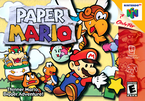 Template:Released Nintendo 64 |
The original Paper Mario, released in Japan as Mario Story and originally known as Super Mario RPG 2, was released for the Nintendo 64 in 2000/2001 to positive media reaction and commercial success. It is set in a paper-based version of the Mushroom Kingdom where as Mario is attending a party at Peach's castle, the palace is suddenly uprooted and lifted into the sky by Bowser's aerial fortress. The Koopa King invades the castle, emerges victorious over Mario, and kidnaps the princess. The story centers on Mario as he tries to reclaim the seven Star Spirits, whom Bowser and his assistant Kammy Koopa had incarcerated in playing cards in an invasion of their residence, Star Haven, during which the tyrant also stole their fabled treasure, the wish-granting Star Rod, which he had used in his defeat of Mario to make himself completely invincible.
The game was rereleased for the Wii Virtual Console in 2007, and for the Wii U Virtual Console in 2015. |
| Paper Mario: The Thousand-Year Door | |
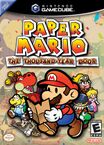 Template:Released Nintendo GameCube |
Paper Mario: The Thousand-Year Door, originally released in Japan as Paper Mario RPG and tentatively known as Mario Story 2 (Japan) and Paper Mario 2 (North America and Europe), was released in 2004 for the Nintendo GameCube. Like its predecessor, it was well received by critics.
The game is set in a cursed island across an unnamed ocean in a remote area of the Mushroom Kingdom. Peach contacts Mario about a treasure map that she had bought in Rogueport, a town of thieving and notorious characters located on the aforementioned island. Once the princess goes missing, Mario takes it upon himself to search for her. Along the way, he must retrieve the seven legendary Crystal Stars, which together unlock the Thousand-Year Door, a mysterious portal fabled to lead to certain fortune. Little does he know, however, that Peach has actually been kidnapped by the Secret Society of X-Nauts, a group of cybernetic soldiers led by Sir Grodus, who are also searching for the Crystal Stars. Eventually, the X-Nauts give Peach's body to be possessed by a demon called the Shadow Queen in a bid to recover her full power, and Mario and his friends must destroy the princess's possessor in order to free her. |
| Super Paper Mario | |
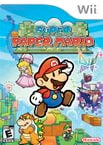 Template:Released Wii |
Super Paper Mario was released for the Wii in 2007 and was the only entry to blend side-scrolling platformer gameplay with RPG gameplay. It was originally developed for the GameCube, but silently moved to its successor platform, the Wii.
Luigi, Bowser, and Peach are kidnapped by the villainous Count Bleck, who controls a book of power called the Dark Prognosticus. To fulfill what is foretold in this tome, he arranges a wedding between Peach and Bowser, and thus summons the Chaos Heart to open a black hole known as "The Void," which will eventually grow large enough to destroy the entire universe. Mario is found by the Pixl character Tippi, who transports him to the interdimensional town of Flipside, where he must travel across various dimensions to collect the eight Pure Hearts, which together can be used to banish the Chaos Heart and reverse the destruction. Mario reunites with Peach and Bowser, who agree to help Mario. Count Bleck periodically sends out his minions: the warrior O'Chunks, the immature shapeshifter Mimi, and the mysterious dimension-traveling jester Dimentio. Luigi is brainwashed into the gentleman-thief alter ego "Mr. L," who also antagonizes the heroes; but upon being defeated in battle, regains his memory and joins his brother's cause. It is gradually revealed as the game progresses that "Count Bleck" is the villainous pseudonym of an insane man named Blumiere, and Tippi is a transformed version of a human figure named Lady Timpani, who was banished to wander between dimensions by Blumiere's disdainful father when he learned of her romantic relationship with his son. Once all eight Pure Hearts have been collected, Mario and company enter Count Bleck's castle, where Bowser, Peach, and Luigi engage in one-on-one battles with Bleck's minions. Mario confronts Bleck but is unable to attack due to the Chaos Heart making him invincible; however, the other three heroes reappear, use the Pure Hearts to halt Bleck's defenses, and help Mario defeat him. Dimentio then becomes the game's true villain; decides to use the Chaos Heart to create a new universe in his own image; and fuses it, Luigi, and himself into a new entity called "Super Dimentio," whom Mario and his friends must use their combined might and the power of the Pure Hearts to defeat in order to restore every world and dimension in the universe. Like the previous two entries, this game received positive reviews and sold well. It was rereleased on the Wii U eShop in 2016. |
| Paper Mario: Sticker Star | |
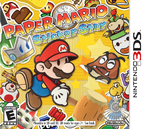 Template:Released Nintendo 3DS |
Paper Mario: Sticker Star, known as Paper Mario: Super Seal in Japan, was released for the Nintendo 3DS in 2012 and incorporates the series' papercraft style into its unique gameplay mechanics. The Mushroom Kingdom welcomes the arrival of the Sticker Comet, and those who wish on it have a good chance of their wish being granted by the Royal Stickers that reside within. Mario attends the Sticker Fest, a festival held in Decalburg to accommodate the comet's arrival, and as the attendees begin to make their wishes, Bowser crashes the celebration and attempts to make his own wish by touching the comet, causing it to explode, and scattering the six Royal Stickers across the kingdom. One Royal Sticker lands on Bowser, corrupting him with its power, and the Koopa King moves to kidnap Peach and knock Mario out. After regaining consciousness, Mario encounters Kersti the sticker fairy, caretaker of the Royal Stickers, who demands that Mario help her recover them. So, they embark on their journey toward Bowser's sky castle and attempt to match his sticker power, defeat him, and get the princess back. |
| Paper Mario: Color Splash | |
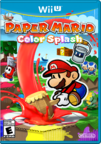 Template:Released Wii U |
Paper Mario: Color Splash was released for the Wii U in 2016. Mario and Peach get a letter from Prism Island, which turns out to be a color-drained Toad, and then set sail for Port Prisma, only to find it deserted, with many spots and objects drained of color. A large metal vault appears at the bottom of the dried-out fountain, which reveals Huey, the paint can character who guards the fountain. Huey asks Mario to assist him in recovering the Big Paint Stars, the main sources of color for the entire island, from Bowser and his Koopalings. While Mario is scouting the island, Peach is kidnapped by Bowser, who had tampered with the Color Fountain to create toxic black paint, which then transformed him into the more malevolent and meaner-spirited Black Bowser. After recovering the Paint Stars, Mario and Huey infiltrate Black Bowser's Castle, where they must halt his weapons factory's operations, defeat Bowser in battle, rescue Peach, and restore peace to the island. |
Crossover
| Title | |
|---|---|
| Cover, original release, and system | Synopsis |
| Mario & Luigi: Paper Jam | |
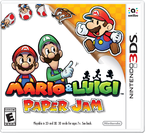 Template:Released Nintendo 3DS |
Mario & Luigi: Paper Jam, known as Mario & Luigi: Paper Jam Bros. in PAL regions, and released for the Nintendo 3DS in 2015, is a crossover between the Paper Mario games and the Mario & Luigi series. While attempting to fix a hole in Peach's castle library, Luigi trips and knocks over a mysterious book containing the Paper Mario world, causing the paper-thin residents within it to spread across the Mushroom Kingdom. Afterwards, Bowser combines his evil army with that of his paper counterpart, and they kidnap Peach and her paper version. Mario and Luigi must now team up with Mario's paper counterpart to set everything right, defeat both Bowsers, and bring all the paper people back into the book.
Paper Jam can be considered the aftermath of Sticker Star and Mario & Luigi: Dream Team, resulting in the sprite-based residents of one universe meeting their paper-thin counterparts from the other one. Paper Mario can use his paper thin body to perform his own unique actions that will help the brothers, or make copies of himself during battle to deal extra damage or attack multiple enemies at once. Mario and other characters also gain their own papercraft versions which can be used in certain sections of the game to defeat papercraft enemies. |
Characters
This section is under construction. Therefore, please excuse its informal appearance while it is being worked on. We hope to have it completed as soon as possible.
Major Protagonists
| Character | ||
|---|---|---|
| Image | Brief Biography | First Paper Mario Appearance |
| Mario | ||
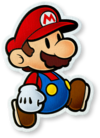
|
Mario is the eponymous main character of the series, often accompanied by different partners throughout each game. As in most games in the Mario franchise, Mario is a silent protagonist, thought he mostly communicates by nodding and hand gestures. | |
| Luigi | ||
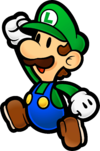
|
Luigi often acts as an NPC, who in Paper Mario stays at the Mario Bros.' House and in Paper Mario: The Thousand-Year Door goes on his own adventure which Mario can hear about if he talks to him. Luigi took on a more major role in Super Paper Mario, where for most of the game he is brainwashed and turned into Mr. L who works for Count Bleck, but after Chapter 6 he is turned back to normal and becomes a playable character. While playing as Luigi, as usual he has a higher jump height and lower ground traction, and he can also do a Super Jump, which can be used to jump super high or deal double-damage to enemies directly above him. In Paper Mario: Sticker Star and Paper Mario: Color Splash, Luigi hides in certain spots in some levels and can be pulled out by using Paperize and Cutout respectively. In the latter, Luigi also helps Mario reach Black Bowser's Castle. | |
| Princess Peach | ||
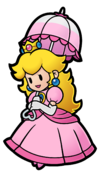
|
Princess Peach is usually the damsel in distress in most of the installments. In Paper Mario and Paper Mario: The Thousand Year Door, the player briefly takes control of her while she tries to find out more about the plans of her kidnappers and give this information to Mario. In Super Paper Mario, she is a more major playable character available after Chapter 1. She can duck under her parasol to become invulnerable to enemy attacks and can also use her parasol to float a long distance in the air. In Paper Mario: Color Splash before she is kidnapped (which happens after obtaining the first Big Paint Star), she can heal Mario fully whenever he speaks with her. | |
| Goombario | ||
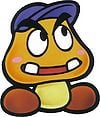
|
Goombario is Mario's first partner in Paper Mario. He was named after Mario himself, and has admired him for a long time. He joins Mario at the beginning of the adventure right when Mario leaves Goombario's house in Goomba Village. In the field, he can give a description of the current area or of anyone. In battle, Goombario can use his Headbonk move to damage an enemy, or he can use Tattle to reveal enemy stats and display their HP permanently. When Super-Ranked, he can Charge which boosts his power for his next attack by 2. When Ultra-Ranked, he can Multibonk where he attacks an enemy until the player misses an action command. | |
| Kooper | ||
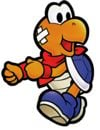
|
Kooper is Mario's second partner in Paper Mario. Kolorado is his idol, and has dreamed of adventuring with him. He joins Mario after retrieving his shell from Fuzzies in Koopa Village. In the field, he can be used to hit switches or collect items from far away or deal a First Strike to enemies. In battle, he can use Shell Toss to attack the enemy at the front or use Power Shell to attack all enemies on the ground. When Super-Ranked, he can use Dizzy Shell to make enemies dizzy. When Ultra-Ranked, he can use Fire Shell to deal fire-damage to all enemies on the ground. | |
| Bombette | ||
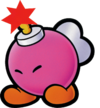
|
Bombette is Mario's third partner in Paper Mario. She was initially one of many Bob-ombs working at Koopa Bros. Fortress until the Koopa Bros. imprisoned her and most of the other Bob-ombs. She joins Mario after he helps her escape her jail cell. In the field, she can blow up cracks in walls or deal a First Strike to an enemy. In battle, she can Body Slam into the enemy at the front or Bomb it. When Super-Ranked, she can use Power Bomb to damage all enemies on the ground. When Ultra-Ranked, she can use Mega Bomb to damage all enemies. | |
| Parakarry | ||
| File:Mario and Parakarry Artwork - Paper Mario.png | Parakarry is Mario's fourth partner in Paper Mario. In this game and in Paper Mario: The Thousand-Year Door, he delivers a letter to Mario which starts off the adventure. He lost a lot of letters throughout the Mushroom Kingdom, and joins Mario after finding his lost letters on Mt. Rugged. In the field, Parakarry can deliver letters to recipients if Mario talks to them while he is active, and he can carry Mario over large gaps. In battle, he can use Sky Dive or Shell Shot to damage one enemy. When Super-Ranked, he can use Air Lift to carry an enemy out of the battle. When Ultra-Ranked, he can use Air Raid to damage all enemies. | |
| Lady Bow | ||
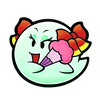
|
Lady Bow is Mario's fifth partner in Paper Mario. She is the master of Boo's Mansion, and after Tubba Blubba began eating Boos, Bootler brought Mario to her where she offers to set free the Star Spirit Skolar (who escaped from Tubba Blubba's Castle) in exchange of defeating Tubba Blubba. She joins Mario to help him do this, then decides to stick with him for the rest of the adventure. In the field, she can make Mario transparent to avoid detection from enemies or pass through obstacles while on a moving surface (e.g a Lava waterfall in Bowser's Castle). In battle, she can Smack one enemy or use Outta Sight to make herself and Mario immune to the next enemy turn, although this will also skip Bow's next turn. When Super-Ranked, she can use Spook to scare enemies away. When Ultra-Ranked, she can Fan Smack an enemy. | |
| Watt | ||
| File:Watt Artwork - Paper Mario.png | Watt is Mario's sixth partner in Paper Mario. She was trapped in a lantern held by a Big Lantern Ghost in Shy Guy's Toy Box, and joins Mario after he rescues her. In the field, she can light up dark areas and reveal hidden blocks. In battle, she can use Electro Dash to attack one enemy and pierces its defense, or use Power Shock to paralyze one enemy. When Super-Ranked, she can use Turbo Charge to boost Mario's attack power. When Ultra-Ranked, she can use Mega Shock to paralyze all enemies. | |
| Sushie | ||
| File:Sushie.png | Sushie is Mario's seventh partner in Paper Mario. She is a babysitter for five Yoshi children on Lavalava Island. After they went missing in Jade Jungle, she joined Mario to find them and then decided to stick with him. In the field, she can ferry Mario across water at certain docks, and can dive briefly. In battle, she can Belly Flop or Squirtone enemy, the latter dealing Water damage. When Super-Ranked, she can use Water Block to boost Mario's defense. When Ultra-Ranked, she can use Tidal Wave to deal Water damage to all enemies. | |
| Lakilester | ||
| File:Lakilester Artwork - Paper Mario.png | Lakilester is Mario's eighth and final partner in Paper Mario. He was a minion of Huff N. Puff and picks a fight with Mario under orders from him. After losing the fight, Lakilester decides to betray Huff N. Puff and joins Mario's side. In the field, Mario can ride on Lakilester's cloud to move at a faster speed than normal, and can hover acrosd spikes and lava. In battle, he can use Spiny Flip to throw a Spiny Egg at an enemy, or use Spiny Surge to throw a bunch of Spiny Eggs at all enemies. When Super-Ranked, he can use Cloud Nine to make enemy attacks sometimes miss Mario. When Ultra-Ranked, he can use Hurricane to blow all enemies away. | |
| Goombella | ||
| File:Goombella2.jpg | Goombella is Mario's first partner in Paper Mario: The Thousand-Year Door. She went to Rogueport to learn about the Legendary Treasure under the city, and joins Mario after he rescues her from Lord Crump and some X-Nauts. She behaves exactly like Goombario in the field and in battle, except she learns Multibonk when Super-Ranked, and when Ultra-Ranked, she can use Rally Wink which lets Mario use another action. | |
| Koops | ||
| File:Koops - PMTTYD.png | Koops is Mario's second partner in Paper Mario: The Thousand-Year Door. Ten years before the events of the game, his father went to fight Hooktail but was believed to have died. Wanting to avenge his father, Koops went with Mario to Hooktail Castle. After defeating Hooktail and realizing his father was alive, Koops decided to continue travelling with Mario. He behaves exactly like Kooper in the field and in battle, except his shell toss in the field can be held down while Mario can move around. When Super-Ranked, he can protect Mario in a Shell Shield. When Ultra-Ranked, he can use Shell Slam to attack all enemies on the ground and pierce their defence. | |
| Flurrie | ||
| File:Flurrie (alt) - Paper Mario The Thousand-Year Door.png | Flurrie is Mario's third partner in Paper Mario: The Thousand-Year Door. She was a retired actress who lives in Boggly Woods and was planning a stage comeback. She joins Mario after he finds her Necklace for her. In the field, she can exhale to reveal hidden things and stop enemies in their tracks. In battle, she can Body Slam an enemy from above or use Gale Force to blow all enemies away. When Super-Ranked, she can use Lip Lock to damage an enemy and heal her own HP. When Ultra-Ranked, she can use Dodgy Fog to make enemie attacks sometimes miss Mario. | |
| Mini-Yoshi | ||

|
Mini-Yoshi is Mario's fourth partner in Paper Mario: The Thousand-Year Door. He hatched from his egg in Glitzville while Mario was fighting in the Glitz Pit, and joined Mario not long afterwards. The player gives him a name beforehand. In the field, Mario can ride him to move at a faster pace and hover over large gaps. In battle, he can Ground Pound an enemy or can Gulp the enemy at the front and spit it at the enemy behind it damaging them both (this is the only way to defeat the Armored Harriers). When Super-Ranked, he can throw Mini-Eggs at enemies to shrink them. When Ultra-Ranked, he can summon a Stampede of Yoshis to attack all enemies. | |
Similarities between the games
- In the first four entries, the story is introduced by a narrator.
- In the four console entries, the story opens up with a letter at the Mario Bros.' House.
- In all five games, Mario has to fight one or more of his allies at least once. In Paper Mario he fights Lakilester, in Paper Mario: The Thousand-Year Door he fights Vivian along with her sisters and also fights the tricked Goombella, Koops, Flurrie and Yoshi with Doopliss, in Super Paper Mario he fights Bowser and Mr. L (Luigi) twice each, in Paper Mario: Sticker Star, each Wiggler Segment is fought, and in Paper Mario: Color Splash, he fights Black Bowser and a group of angry Toads.
- In the first three games, Mario is able to temporarily transform into an 8-bit version of himself: after falling into a vase in Boo's Mansion in the first game, after landing behind a curtain in X-Naut Fortress in the second game, and whenever he obtains a Mega Star in the third game.
- Each of the first three games has narration with Mario falling asleep. When he wakes up, the storyteller asks if he's been listening, followed by Mario lying by nodding. In Paper Mario, Madam Merlar tells the story. In Paper Mario: The Thousand-Year Door, Luigi and the shopkeeper in Twilight Town tell the stories. In Super Paper Mario, Merlumina tells the story.
- All five games involve one or more giant Bloopers as a boss.
- In Color Splash, the giant Blooper is a target to fire cannonballs at.
- All five games involve a grassland setting followed by a fortress of some sorts during the first chapter or world in the game.
- All five games have at least one game show event. In Paper Mario there is the 64th Trivia Quiz-Off, in Paper Mario: The Thousand-Year Door there are the two Super Fun Quirk Quizes, in Super Paper Mario there is "That's My Merlee!" Show, and in Paper Mario: Sticker Star and Paper Mario: Color Splash, there is Snifit or Whiffit.
- In all five games, the final boss is a powerful version of a member of the team of Super Paper Mario: in the first game it is an invincible Bowser using the Star Rod, in the second game it is Princess Peach possessed by the Shadow Queen, in the third game it is Super Dimentio who is a mixture of Dimentio, the Chaos Heart and Mr. L, in the fourth game it is a giant Bowser turned insane by a Royal Sticker, and in the fifth game is Bowser infused with black paint.
- All five games had a remix of the Super Star theme play somewhere. In Paper Mario, when Mario runs around a certain Candy Cane in Pleasant Path, the theme will start playing. In Paper Mario: The Thousand-Year Door, when playing the Bowser segments, if the player collects enough Meat in a level, Bowser grows huge and the theme plays. In Super Paper Mario, when the player obtains a Mega Star, the theme plays, and in Paper Mario: Sticker Star and Paper Mario: Color Splash, the theme plays when the player grabs a Star.
Names in other languages
| Language | Name | Meaning |
|---|---|---|
| Japanese | ペーパーマリオ Pēpā Mario |
Paper Mario |
Trivia
- The Paper Mario title itself is mentioned in several games. In the party at the end of Paper Mario, a Bumpty mentions that Herringway is writing a novel called "Paper Mario". The same occurs in Paper Mario: The Thousand-Year Door with the blue Toad living in a house in the Rogueport west side, who also writes a Paper Mario novel based off Mario's adventures, which gets adapted into a play.
- The novel written by Herringway is titled "Mario Story" in Japanese. In Luigi's Mansion, Neville can be seen reading a book with the same title.
